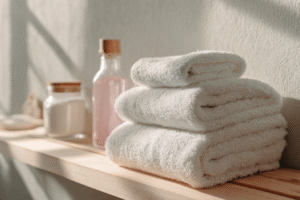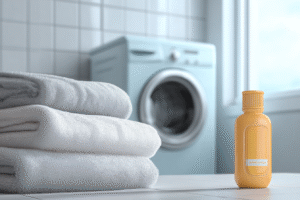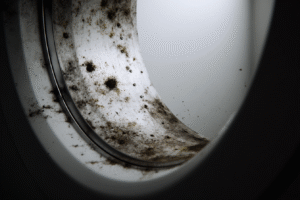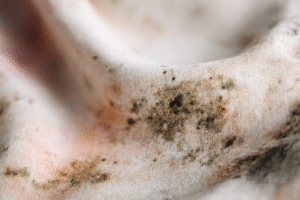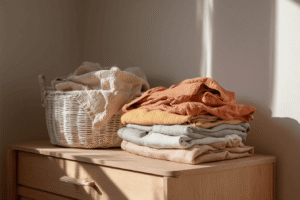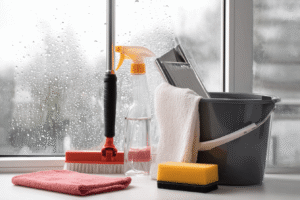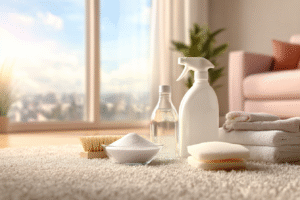Résumer cet article avec :
Discovering mould on your favourite fabrics can be frustrating, but you don’t have to bin them just yet. We connect you with the knowledge and techniques needed to tackle mould effectively, restoring your clothes, curtains, and upholstery safely. Whether you’re dealing with minor spots or stubborn black mould, our comprehensive guide covers everything from white vinegar solutions to professional-grade treatments.
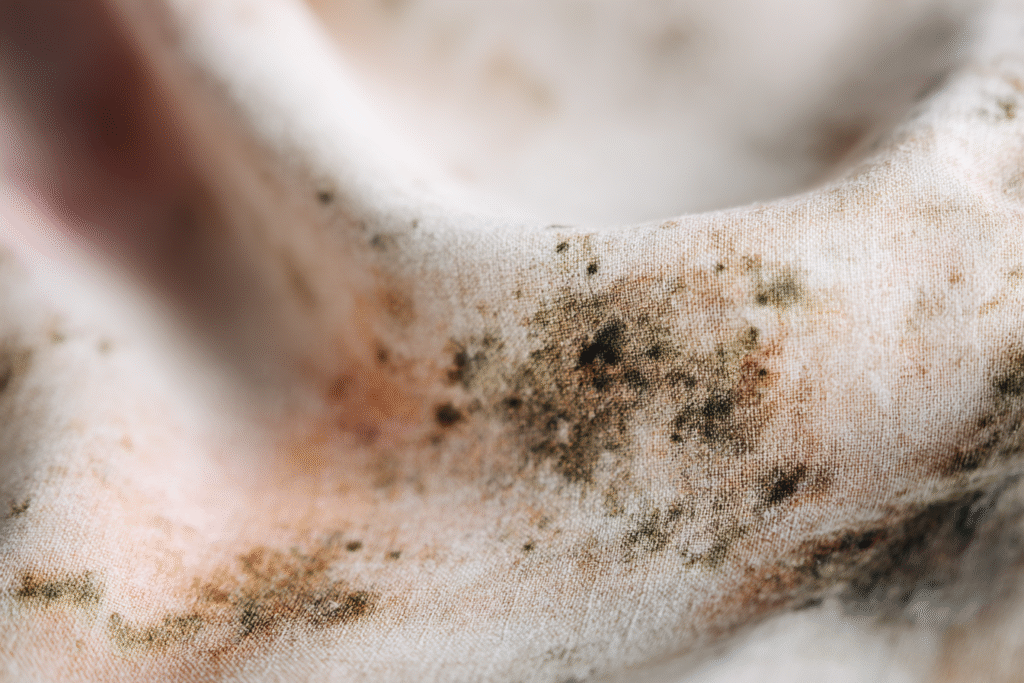
Safety First: Preparing for Mould Removal
Essential Safety Equipment You’ll Need
Before tackling any mould removal, proper protective gear is non-negotiable. Rubber gloves, eye protection, and a quality face mask prevent direct contact with harmful mould spores that become airborne during cleaning.
| Equipment | Purpose | Why You Need It |
|---|---|---|
| N95 or FFP2 Mask | Blocks mould spores | Prevents respiratory irritation |
| Rubber Gloves | Hand protection | Stops skin contact with cleaning solutions |
| Safety Goggles | Eye protection | Shields from splashing cleaning products |
| Old Clothes | Body coverage | Protects skin and prevents cross-contamination |
Fresh air circulation is equally vital – open windows and doors to prevent spore buildup. Keep a spray bottle handy for cleaning solutions, and ensure you have a clean toothbrush for stubborn spots.
Remember: mould removal isn’t just about the fabric – you’re protecting your health too.
Creating a Safe Working Environment
Workspace preparation sets you up for successful mould removal without spreading spores throughout your home. Choose a well-ventilated area away from carpeted rooms – hard surfaces are easier to disinfect afterwards.
Key environmental setup steps:
- Isolate the work area using plastic sheeting to contain spores
- Position fans to blow air outside, never towards clean areas
- Keep humidity levels below 50% using a dehumidifier if needed
- Prepare a damp place nearby for immediate disposal of contaminated materials
| Room Type | Suitability | Why |
|---|---|---|
| Bathroom | Excellent | Good ventilation, easy cleanup |
| Garage | Good | Isolated, hard surfaces |
| Bedroom | Poor | Fabric fibres trap spores |
Temperature control matters too – avoid high temperatures that can make spores more active. You want cool, dry conditions that limit mould growth while you work.
When to Call Professional Cleaning Services
Some mould situations require expert intervention rather than DIY attempts. Large-scale contamination covering more than 10 square feet needs professional assessment – you’re looking at potential structural issues beyond simple surface cleaning.
Call the professionals when:
- Black mould appears (potentially toxic Stachybotrys species)
- Delicate fabrics like silk, vintage items, or expensive upholstery are affected
- Persistent odours remain after multiple cleaning attempts
- You experience health symptoms like persistent coughing or respiratory issues
| DIY Suitable | Professional Required |
|---|---|
| Small spots under 3 feet | Widespread growth |
| Cotton, polyester fabrics | Antique textiles |
| Surface mould only | Deep fabric penetration |
Professional services offer specialised equipment, HEPA filtration, and safe disposal methods. They can identify moisture sources and prevent recurrence – something home treatments often miss.
Step-by-Step Guide to Kill Mold on Fabric
Initial Assessment and Mould Identification
Proper identification determines your entire cleaning approach – different mould types require specific treatments. Start by examining the fabric type and mould characteristics under good lighting.
Visual inspection checklist:
- Colour patterns – white, green, black, or grey mould growth
- Texture changes – fuzzy, slimy, or powdery surfaces
- Spread pattern – isolated spots versus widespread contamination
- Fabric condition – check for weakened fibres or holes
| Mould Type | Appearance | Risk Level |
|---|---|---|
| Surface mildew | White/grey, powdery | Low |
| Green mould | Fuzzy, bright green | Moderate |
| Black mould | Dark, slimy patches | High |
Test the affected area gently – if mould spores brush off easily, you’re dealing with surface growth. Stubborn mould stains that resist gentle brushing indicate deeper penetration requiring intensive treatment.
Check surrounding areas for excess moisture sources and musty odour – these reveal whether you’re treating symptoms or the root cause.
Pre-Treatment: Brushing and Vacuuming
Mechanical removal comes first – think of this as your opening act before the main cleaning show. Start outdoors if possible to prevent spores from spreading indoors.
Your pre-treatment toolkit:
- HEPA vacuum with brush attachment for effective spore capture
- Soft-bristled brush for gentle surface work
- Disposable bags for immediate spore containment
| Vacuum Type | Effectiveness | Best For |
|---|---|---|
| HEPA filtered | Excellent | All fabric types |
| Standard vacuum | Poor | Avoid – spreads spores |
| Shop vacuum | Good | Outdoor use only |
Brush gently first to loosen surface mould, then vacuum using overlapping strokes. Work from clean areas towards contaminated zones to avoid cross-contamination.
Pro tip: Empty your vacuum immediately after use and dispose of the bag safely. Good news – this simple prep work removes up to 95% of loose mould spores, making your chemical treatment far more effective.
Cleaning Mold with White Vinegar Solution
White vinegar proves the most effective natural mould killer for fabric cleaning. Mix equal parts distilled white vinegar and water in a spray bottle for standard treatment, or use undiluted vinegar for stubborn mould stains.
| Solution Strength | Vinegar:Water Ratio | Best For |
|---|---|---|
| Mild treatment | 1:3 | Delicate organic fabrics |
| Standard cleaning | 1:1 | Most fabric types |
| Heavy-duty | Undiluted | Persistent build-up |
Application method:
- Spray the vinegar solution generously over affected areas
- Allow to penetrate for 30-60 minutes without scrubbing
- Work from outside the stain inwards to prevent spreading
The acetic acid in vinegar kills mould spores whilst being gentler than bleach or hydrogen peroxide. Test on an inconspicuous area first to check for colour fastness on delicate materials.
Machine Washing Mouldy Clothes Effectively
Your washing machine becomes your most powerful ally once you’ve completed the pre-treatment phase. The key lies in combining the right temperature with proper mould-killing agents.
| Water Temperature | Fabric Type | Effectiveness |
|---|---|---|
| 60-90°C | Cotton, linen | Kills all mould spores |
| 40-60°C | Synthetics, mixed | Moderate effectiveness |
| 30°C | Delicates | Surface cleaning only |
Essential washing steps:
- Add a cup of borax or white vinegar to the detergent compartment
- Select the longest cycle available for maximum mould elimination
- Never mix mouldy clothes with clean items in the same load
The hot water destroys mould spores whilst the extended cycle ensures thorough penetration. Remember to remove items immediately after washing to prevent humid environments that encourage regrowth.
Tackling Specific Fabric Challenges
How to Clean Mould from Curtains and Blinds
Window treatments present unique challenges due to their proximity to condensation-prone areas. Fabric blinds require different approaches than curtains, whilst health risks from prolonged exposure make swift action vital.
Treatment varies by material type:
| Material | Cleaning Method | Drying Approach |
|---|---|---|
| Fabric curtains | Machine wash with baking soda | Sunlight exposure preferred |
| Fabric blinds | Hand wash individual slats | Air dry completely |
| PVC blinds | Wipe with mildew remover | Quick towel dry |
Start by removing curtains from rails – never treat them whilst hanging. For fabric blinds, detach individual slats for thorough cleaning. Pre-treat with white vinegar solution before washing.
Avoid common mistakes:
- Don’t put wet clothes in the laundry basket with clean items
- Never use hot water on delicate fabric blinds
- Skip the tumble dryer to prevent further damage
Position treatments near windows for maximum sunlight exposure during drying – UV rays provide natural disinfection whilst preventing mould from clothing spreading to nearby textiles.
Removing Mould from Fabric Furniture and Couches
Upholstered furniture demands a gentler approach than machine-washable items, yet requires thorough treatment to prevent health risks from mould spores embedded deep within cushions.
| Furniture Type | Treatment Method | Drying Requirements |
|---|---|---|
| Fabric sofas | Vinegar solution spray | Dehumidifier essential |
| Leather couches | Damp cloth only | Sunlight preferred |
| Cushion covers | Remove and machine wash | Air dry completely |
Effective way to tackle fabric furniture:
- Test cleaning solutions on hidden areas first
- Work from outside mould stains inward to prevent spreading
- Use soft-bristled brush for gentle scrubbing action
Professional cleaning becomes necessary when mould penetrates foam padding or covers extensive surface areas. Remember to address moisture sources – that damp basement or leaky window – before treating your furniture, or you’ll face the same problem within weeks.
Treatment for Delicate and Non-Washable Materials
Silk, wool, and dry-clean-only items need gentler approaches than standard fabric cleaning methods. These precious materials can’t withstand harsh treatments, yet mould spores still pose serious health risks.
| Material Type | Safe Treatment | What to Avoid |
|---|---|---|
| Silk fabrics | White vinegar dabbing | Hot water, bleach |
| Wool items | Professional dry cleaning | Machine washing |
| Vintage textiles | Soft brush removal | Chemical solutions |
Essential steps for delicate materials:
- Test any solution on hidden seams first
- Dab rather than rub to prevent fabric damage
- Work in well-ventilated areas with protective equipment
- Air dry completely in indirect sunlight
When mould penetrates deep into delicate fibres, professional restoration often proves more cost-effective than risking irreversible damage through DIY attempts.
Prevention and Maintenance Tips
Creating a Mould-Free Environment
Environmental control beats reactive cleaning every time – prevention stops problems before they start.
Key environmental factors to monitor:
- Humidity levels below 50% using quality dehumidifiers
- Air circulation through strategic fan placement
- Temperature consistency avoiding warm, stagnant pockets
- Moisture sources like leaky pipes or poor ventilation
| Room Type | Target Humidity | Essential Equipment |
|---|---|---|
| Bedrooms | 30-50% | Dehumidifier, ventilation |
| Bathrooms | Below 50% | Exhaust fans, quick drying |
| Storage areas | 30-40% | Silica gel packets, airflow |
Smart storage makes the difference. Never pack damp items away, and check stored fabrics monthly for early warning signs. Good ventilation transforms problem areas into mould-resistant zones.
Regular moisture monitoring with simple humidity meters gives you control before issues develop. Your fabrics stay fresh when their environment stays hostile to unwanted growth.
Best Storage Practices for Your Fabrics
Proper storage containers make all the difference between fresh fabrics and mouldy disasters waiting to happen.
| Container Type | Moisture Protection | Best For |
|---|---|---|
| Airtight plastic bins | Excellent | Long-term storage |
| Breathable fabric bags | Good ventilation | Delicate items |
| Vacuum-sealed bags | Outstanding | Space-saving storage |
Smart storage essentials:
- Silica gel packets absorb excess moisture naturally
- Cedar blocks repel pests whilst controlling humidity
- Clean, completely dry items only – no exceptions
- Regular inspections every few months catch problems early
Never store fabrics directly on concrete floors where moisture seeps upward. Raise containers on pallets or shelving instead. Good airflow around storage areas prevents stagnant conditions that mould loves.
Space items loosely rather than cramming everything together – fabrics need breathing room to stay fresh and mould-free.
What to Do If Mould Stains Won’t Budge
Some stubborn stains refuse to surrender despite your best efforts. When standard treatments fail, escalate your approach systematically rather than giving up.
Advanced treatment options:
| Stain Severity | Next Step | Success Rate |
|---|---|---|
| Light remnants | Lemon juice + salt paste | High for cotton |
| Deep stains | Hydrogen peroxide soak | Moderate |
| Set-in marks | Professional restoration | Variable |
Try enzyme-based cleaners designed for protein stains – they break down mould residue at molecular level. Soak overnight in cool water with these specialised products.
When all else fails: Professional dry cleaning or restoration services have industrial-strength treatments unavailable to home users. They can assess whether fabric replacement makes more financial sense than continued treatment attempts.
Don’t waste months battling impossible stains – sometimes accepting defeat and replacing the item proves the wisest choice for your time and sanity.

 ChatGPT
ChatGPT
 Mistral
Mistral
 Claude
Claude
 Perplexity
Perplexity


